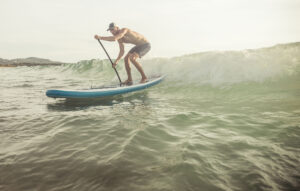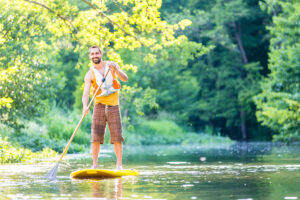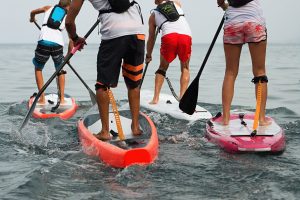
Image by Sanchik, Shutterstock
Paddle boarding — also known as stand-up paddle boarding (SUP) — offers a blend of physical activity and relaxation. However, like any new skill, it comes with a learning curve. If you’re a beginner eager to explore the world of paddle boarding, avoiding common mistakes is key to ensuring a safe and enjoyable experience.
Embrace the learning process, and don’t be discouraged by a few stumbles along the way. By holding the paddle correctly, perfecting your paddling technique, prioritizing safety, staying informed about weather conditions, and inflating your board to the correct PSI, you’ll be well on your way to becoming a paddleboarding pro, connecting with nature, getting some exercise, and experiencing a sense of tranquility on the water.

Image by oneinchpunch, Shutterstock
So, whether you’re gliding along a calm lake or tackling gentle waves, here are five common paddle boarding mistakes that beginners often make, along with guidance on how to sidestep them. Read on to ensure your paddle boarding journey is nothing short of extraordinary.
Holding the Paddle Incorrectly
Imagine you’re out on the water, paddle in hand. But you’re holding the paddle incorrectly. This can lead to frustration, inefficiency, discomfort and even an increased likelihood of falling off.
You want to hold the paddle with one hand on top of the handle and the other hand a little down the stick. The paddle blade (flat part) should face away from you. When you put the blade in the water, scoop it like you’re scooping ice cream, then pull it back toward you. This helps you move through the water and steer your board. Just remember: Blade away from you, scoop and pull.

Image by Kasefoto, Shutterstock
Also, be sure your paddle is the right height for you. Adjusting your paddle’s height on the water is easy. First, make sure your paddle is super tall. Hold it above your head with both hands and make sure your arms are straight. Then, put the paddle in the water and stand up on your board. If the handle is way higher than your hands, you need to make the paddle shorter. Lift up the handle, find the little button or clamp and slide the handle down. Try again, and if it’s just right you’re good to go. Keep trying until it feels comfy.
Unable to Paddle Straight
One of the most frequent frustrations for beginner stand up paddle boarders is the inability to paddle straight on the water. The solution? Focus on your posture and paddle technique. Keep your feet parallel and hip-width apart on the board — distributing your weight evenly. When paddling, use a full range of motion, submerging your entire blade into the water and pulling it back along the side of the board.
To paddle straight, you’ll need to switch sides with each paddle. Engage your core and rotate your torso with each stroke, providing stability and steering precision.
With practice, you’ll see progress. And once you’re paddling straight, you’ll be able to enjoy paddle boarding even more.
Lack of Proper Safety Equipment
For any water sport, safety should always be a priority. Especially when you’re paddle boarding on a lake. Regardless of your skill level, you should wear a personal flotation device (PFD) to ensure your safety in case of unexpected falls or currents. Additionally, a leash connecting you to the board is crucial, preventing your board from drifting away and keeping you in control. It’s also a good idea to have a whistle.

Image by Kzenon, Shutterstock
Before heading out, it’s best to research the rules for the body of water you’ll be on. The safety gear you need can vary for different locations. Some places might require additional safety gear like helmets if you’re paddle boarding in areas with lots of boats or rapids.
Being Unaware of Weather Conditions
The sun is shining, the water looks inviting, and you’re ready to embark on your paddle boarding adventure. However, neglecting to check the weather can quickly turn your outing into a less-than-pleasant experience.
Wind and currents can impact your ability to maneuver, while sudden weather changes could catch you off guard.

Image by Pavel1964, Shutterstock
Before you head out, take a moment to check the weather forecast and assess any potential risks. It’s better to postpone your paddle session than to face unnecessary challenges.
Incorrect PSI for Inflatable Paddle Boards
You’ve unpacked your inflatable paddle board and you’re eager to get on the water. But did you inflate it to the correct PSI? Under-inflated boards lead to reduced stability and performance, while over-inflated boards can feel like floating on a hard surface.
It’s best to follow the manufacturer’s guidelines to ensure you inflate your board to the recommended PSI for optimal balance and comfort. A properly inflated board enhances your overall experience and makes it easier to find your balance.
Suzanne Downing is an outdoor writer and photographer in Montana with an environmental science journalism background. Her work can be found in Outdoors Unlimited, Bugle Magazine, Missoulian, Byline Magazine, Communique, MTPR online, UM Native News, National Wildlife Federation campaigns and more.
 Your Privacy Choices
Your Privacy Choices
 The
The